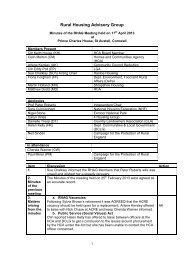Rapid Evidence Assessment of the Research ... - Rural Housing
Rapid Evidence Assessment of the Research ... - Rural Housing
Rapid Evidence Assessment of the Research ... - Rural Housing
You also want an ePaper? Increase the reach of your titles
YUMPU automatically turns print PDFs into web optimized ePapers that Google loves.
<strong>Rapid</strong> <strong>Evidence</strong> <strong>Assessment</strong> <strong>of</strong> <strong>the</strong> <strong>Research</strong> Literature on <strong>the</strong> Purchase and Use <strong>of</strong> Second Homes<br />
What is <strong>the</strong> geographical distribution <strong>of</strong> second homes across England, and<br />
what are <strong>the</strong> characteristics <strong>of</strong> places with a high concentration <strong>of</strong> second<br />
homes?<br />
223. In Chapter Five it was shown that <strong>the</strong>re is limited and patchy research evidence on <strong>the</strong> concentration <strong>of</strong><br />
second homes at sub-local authority level and <strong>the</strong>re is a lack <strong>of</strong> detailed systematic nationwide research on <strong>the</strong><br />
socio-economic characteristics, and housing markets, <strong>of</strong> locations with large proportions <strong>of</strong> second homes.<br />
224. It was also shown that <strong>the</strong> location <strong>of</strong> second homes suggests two separate phenomena: urban second<br />
homes (especially in London) and rural second homes (especially in South West England and attractive rural<br />
locations). <strong>Research</strong> that contrasted <strong>the</strong> nature and functions <strong>of</strong> <strong>the</strong>se two categories would be valuable. This<br />
work might compare second homes used for <strong>the</strong> journey to work with second homes used as places for<br />
leisure.<br />
225. There is clear evidence based on Council Tax records <strong>of</strong> <strong>the</strong> regional and local authority distribution <strong>of</strong><br />
second homes. This has been used in systematic research studies. This same evidence base could be used to<br />
provide a more complete picture, than currently exists, <strong>of</strong> more localised (sub-local authority) concentrations <strong>of</strong><br />
second homes.<br />
226. There is a lack <strong>of</strong> detailed systematic nationwide research on <strong>the</strong> socio-economic characteristics <strong>of</strong><br />
locations with large proportions <strong>of</strong> second homes. Such research might usefully examine both rural and urban<br />
second homes. It could, fur<strong>the</strong>rmore, examine <strong>the</strong> relationships between <strong>the</strong> degree <strong>of</strong> second home<br />
ownership and a series <strong>of</strong> local housing market and socio-economic indicators. This could include <strong>the</strong><br />
relationships <strong>of</strong> second home ownership to house prices, housing availability in <strong>the</strong> private and social sectors,<br />
housing production, incomes and employment.<br />
227. This indicates <strong>the</strong> need for two types <strong>of</strong> research: (1) behavioural research; and (2) desk-top data-based<br />
research on <strong>the</strong> relationships between second homes and <strong>the</strong> socio-economic features <strong>of</strong> <strong>the</strong>ir localities. This<br />
should be carried out for a variety <strong>of</strong> locations and geographical levels, including sub-local authority level.<br />
What are <strong>the</strong> social and demographic characteristics <strong>of</strong> those buying second<br />
homes?<br />
228. Chapter Six highlighted <strong>the</strong> lack <strong>of</strong> up-to-date information on <strong>the</strong> socio-demographic pr<strong>of</strong>ile <strong>of</strong> second<br />
home owners in England and <strong>the</strong> absence <strong>of</strong> published detailed local case studies on <strong>the</strong> characteristics <strong>of</strong><br />
second home owners.<br />
229. It was suggested that <strong>the</strong> data and information gaps could be addressed by: (1) encouraging<br />
Communities and Local Government to review <strong>the</strong> Survey <strong>of</strong> English <strong>Housing</strong> so that it includes, once again, a<br />
wider range <strong>of</strong> questions on <strong>the</strong> socio-demographic pr<strong>of</strong>ile <strong>of</strong> second home owners; and (2) investigating <strong>the</strong><br />
potential <strong>of</strong> linking Survey <strong>of</strong> English <strong>Housing</strong> data with commercial geo-demographic classification systems<br />
such as ACORN and MOSAIC.<br />
230. It was also argued that that local research on second home ownership should generate information on<br />
<strong>the</strong> characteristics <strong>of</strong> second home owners. One possible approach would be to investigate whe<strong>the</strong>r subregional<br />
housing market assessments and housing needs analysis could provide such information.<br />
56






